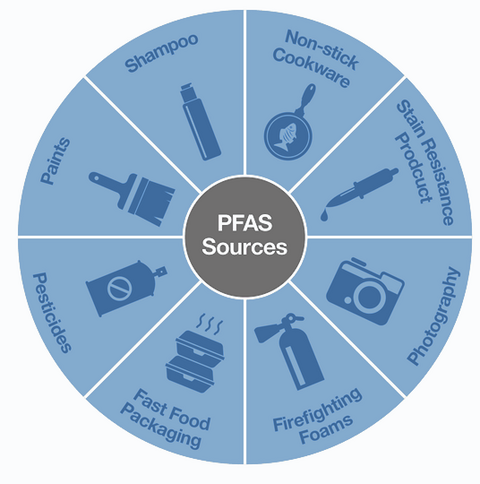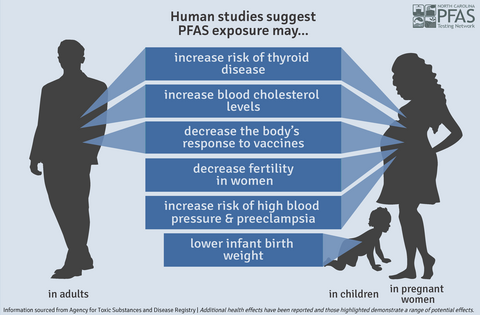| Author: Trevor Walker | Date of publication: July 03, 2023 |
Unmasking PFAS: Understanding The Hidden Environmental Threat
Unveiling the Unseen Enemy - PFAS
In the realm of environmental conservation, there are threats that make headlines - the vivid images of deforestation, the colossal plastic islands floating in our oceans, the imposing challenges of a changing climate. But there's another equally dangerous yet insidious foe that largely remains in the shadows. This invisible threat is a group of chemicals known as Per- and polyfluoroalkyl substances, or PFAS for short. While their name may not ring a bell for most people, these substances are so widespread that they're almost certainly part of your daily life.
This article aims to unmask these hidden enemies, giving you an understanding of their ubiquity, their characteristics, and, most importantly, the ways we can combat them.
Decoding PFAS: Their Ubiquity and Chemical Characteristics
PFAS is a large family of synthetic chemicals that have been used in industry and consumer products worldwide since the 1950s. They're found in everything from non-stick pans, water-resistant clothing, and stain-resistant fabrics to food packaging, firefighting foams, and even some types of cosmetics.
Their widespread use is not without reason. PFAS are prized for their stability and their ability to repel both water and oil, properties that make them incredibly versatile in a wide array of applications.
At a chemical level, PFAS are carbon chains on which fluorine atoms are tightly bound. This strong carbon-fluorine bond is what gives PFAS their stability and resistance to both heat and chemical reactions. They're often referred to as 'forever chemicals,' a term that reflects their persistent nature. Once released into the environment, PFAS don't break down easily. They can linger in the water, air, and soil for many years, leading to widespread contamination.
The ubiquity of PFAS is alarming, but what's even more concerning are the potential health and environmental risks they pose due to their stability and bioaccumulative characteristics. In the next sections, we will dive into the environmental impact of PFAS and their effects on human health, shedding light on why these substances are a growing concern for scientists, regulators, and the general public alike.

Everyday Encounters: How PFAS Permeate our Daily Lives
Despite their rather technical name, PFAS are more closely intertwined with our everyday lives than most of us realize. The non-stick pan you use to cook your breakfast? It likely contains PFAS.
That stain-resistant carpet or water-repellent outdoor gear? PFAS again. These chemicals even make their way into our food through PFAS-laden food packaging, and into our bodies through contaminated water or air.
The pervasiveness of PFAS isn't restricted to our homes and consumer goods. They're also widely used in various industrial applications. Firefighting foams often contain PFAS due to their ability to smother flammable liquid fires. In manufacturing processes, PFAS are utilized for their unique properties, such as their resistance to heat and their ability to repel oil and water.
This widespread use and subsequent disposal have led to the omnipresence of PFAS in our environment, underscoring the urgent need to understand and mitigate their impact. Which brings us to our next section - the environmental implications of these 'forever chemicals.

PFAS and The Planet: A Deep Dive into Environmental Consequences
The robustness that makes PFAS so useful in various applications is also what makes them a significant environmental concern. Their resistance to heat, water, oil, and chemical reactions means that once they're released into the environment, they stick around for a long time. These chemicals don't just linger; they travel, moving through soil, entering waterways, and even making their way into the air.
Because of their persistence, PFAS have been found in some of the most remote corners of the planet. They've been detected in polar bears in the Arctic, in deep-sea creatures, and even in rainwater. This widespread contamination has significant implications for ecosystems. PFAS can accumulate in plants and animals, potentially impacting wildlife health and throwing delicate ecological balances into disarray.
The impact on aquatic ecosystems is particularly concerning. PFAS can contaminate both freshwater and marine environments, affecting a wide range of aquatic life forms. The potential for bioaccumulation and biomagnification - where the concentration of PFAS increases higher up the food chain - poses significant risks.
Health Under Siege: Unpacking the Impact of PFAS on Human Health
PFAS are not just an environmental issue; they pose significant potential risks to human health as well. Due to their pervasive presence in our daily lives and their propensity for bioaccumulation, almost all people have detectable levels of PFAS in their bodies. This ubiquitous exposure has sparked concerns among researchers and health professionals about the potential health effects of these chemicals.
Various studies have linked long-term exposure to certain types of PFAS to a range of health issues. These include hormonal disruptions, increased cholesterol levels, and weakened immune system response. There's also growing evidence suggesting possible links to more severe conditions such as kidney and testicular cancer, thyroid disease, and pregnancy complications. While further research is needed to fully understand the breadth and extent of these health risks, the current findings underscore the need for vigilance and proactive measures to reduce exposure to these chemicals.

Navigating through the PFAS Storm: Current Countermeasures
As we grapple with the PFAS challenge, research is intensifying to develop more effective ways to detect, remove, and destroy PFAS. This drive for innovation spans advancements in water filtration systems, groundbreaking remediation techniques for contaminated sites, and the development of safer alternatives for industrial and consumer applications.
However, amid this landscape of promising research and development, one solution stands out, demonstrating exceptional promise and efficacy - Tektoseal Active from HUESKER.
Tektoseal Active is more than just another innovation; it's a game-changer in the realm of geosynthetics. It has been uniquely designed to trap PFAS in soil, forming a robust barrier that prevents their spread and secures our crucial water sources from contamination. What makes Tektoseal Active so significant is not only its effective functionality but also its integration into existing environmental systems — it represents a powerful solution that harmonizes with the environment, rather than disrupting it.
With Tektoseal Active, we're not merely responding to the PFAS challenge; we're taking a decisive leap forward in our ability to manage it. Through such pioneering solutions, we can truly make strides in our journey towards a safer, cleaner future.
Our Shared Responsibility in Tackling the PFAS Challenge
While the challenges posed by PFAS are considerable, they are not insurmountable. The situation calls for collective action from all quarters - governments, industry, researchers, and individuals alike. As consumers, we can make more informed choices, favoring PFAS-free products where possible. As voters and citizens, we can support policies and regulations that limit PFAS use and promote transparency in their production and disposal.
The PFAS challenge is indeed a formidable one, but it also provides an opportunity. An opportunity to foster innovation, to champion sustainability, and to safeguard our health and the environment for generations to come. Unmasking PFAS is just the first step. Now, armed with understanding and backed by science, we can face the PFAS storm head-on and navigate our way to a safer, cleaner future.
Trevor Walker
Author
Business Development Manager - Environmental
Fort Collins, Colorado
USA
Cell: 704.491.6931
Mail: twalker(at)HUESKER.com








